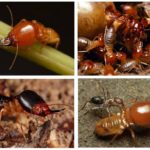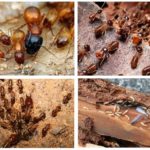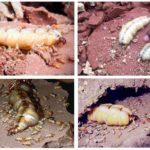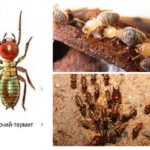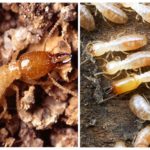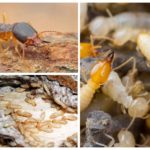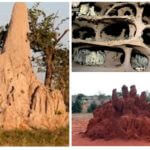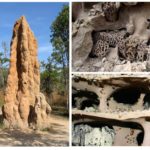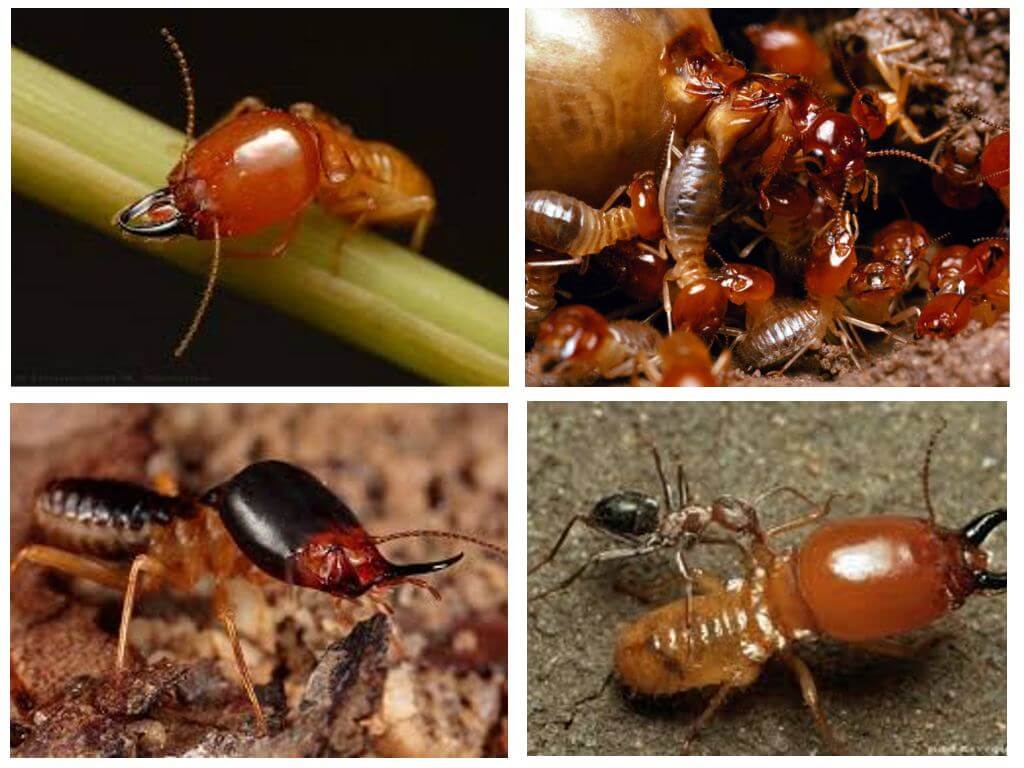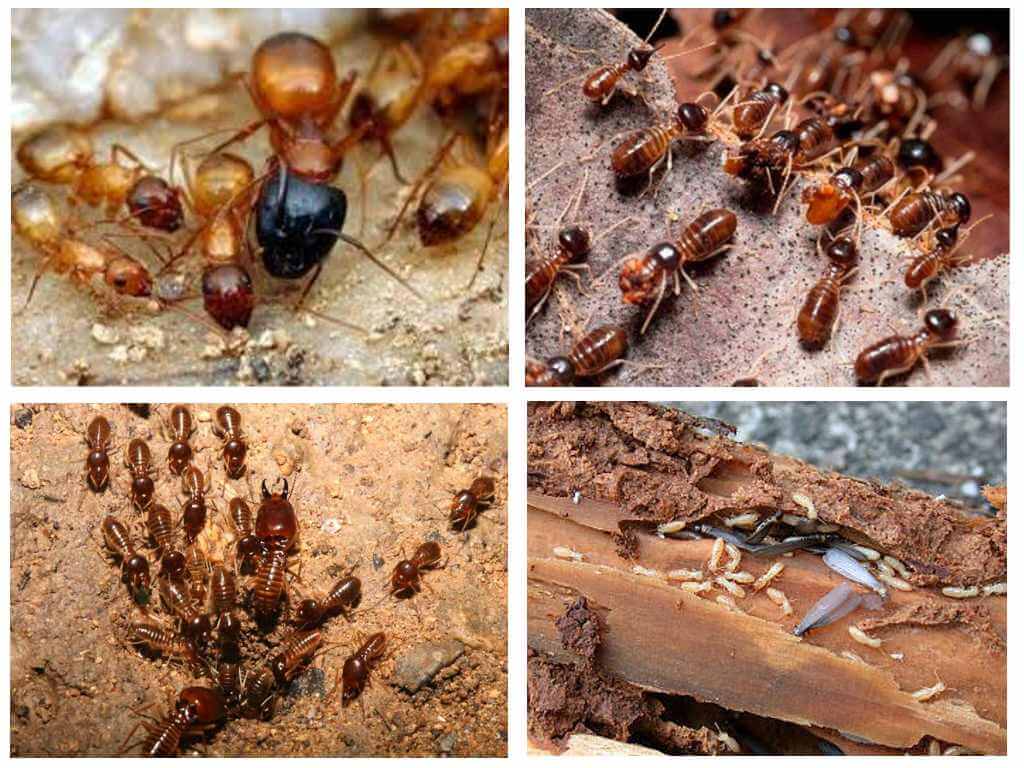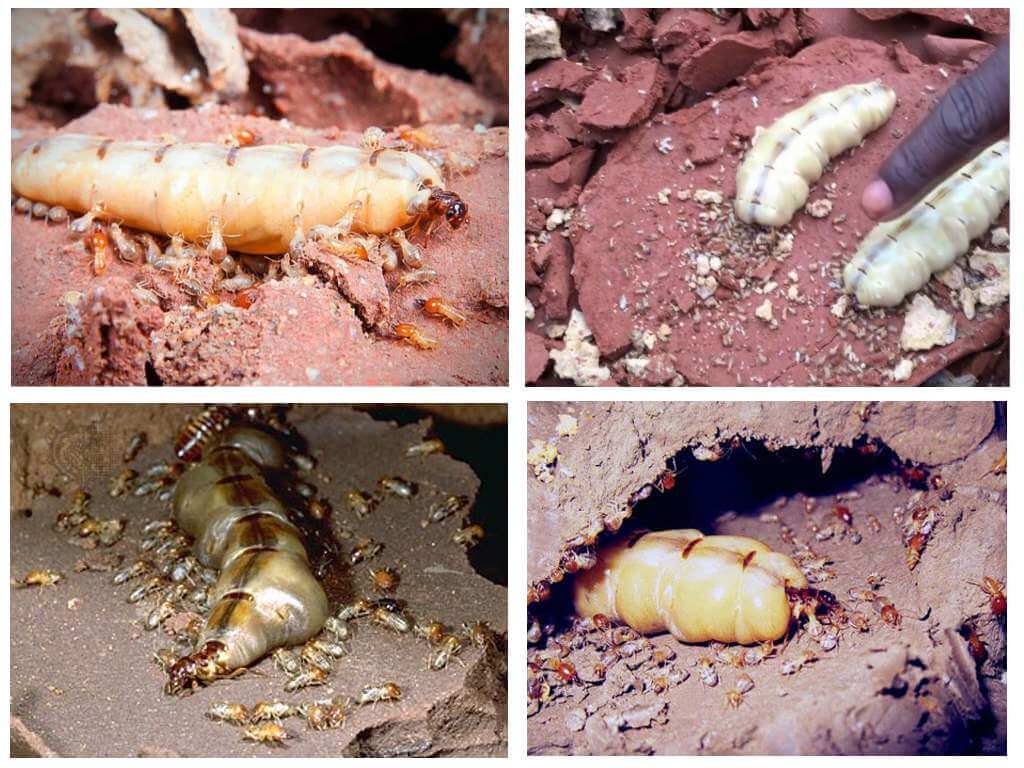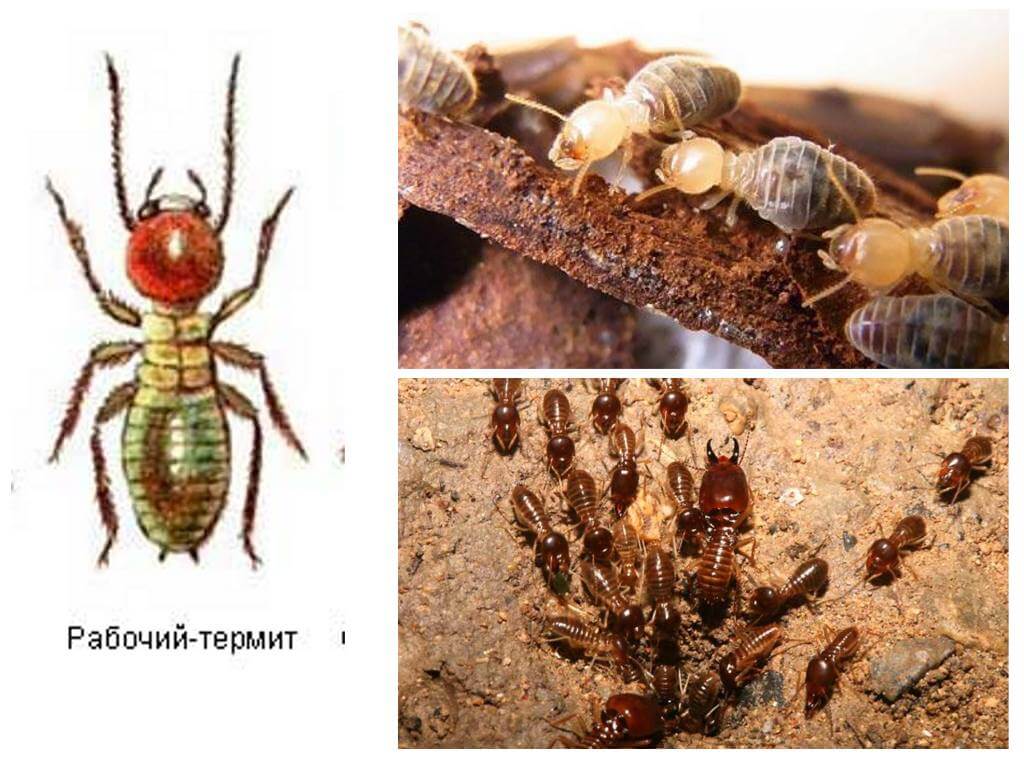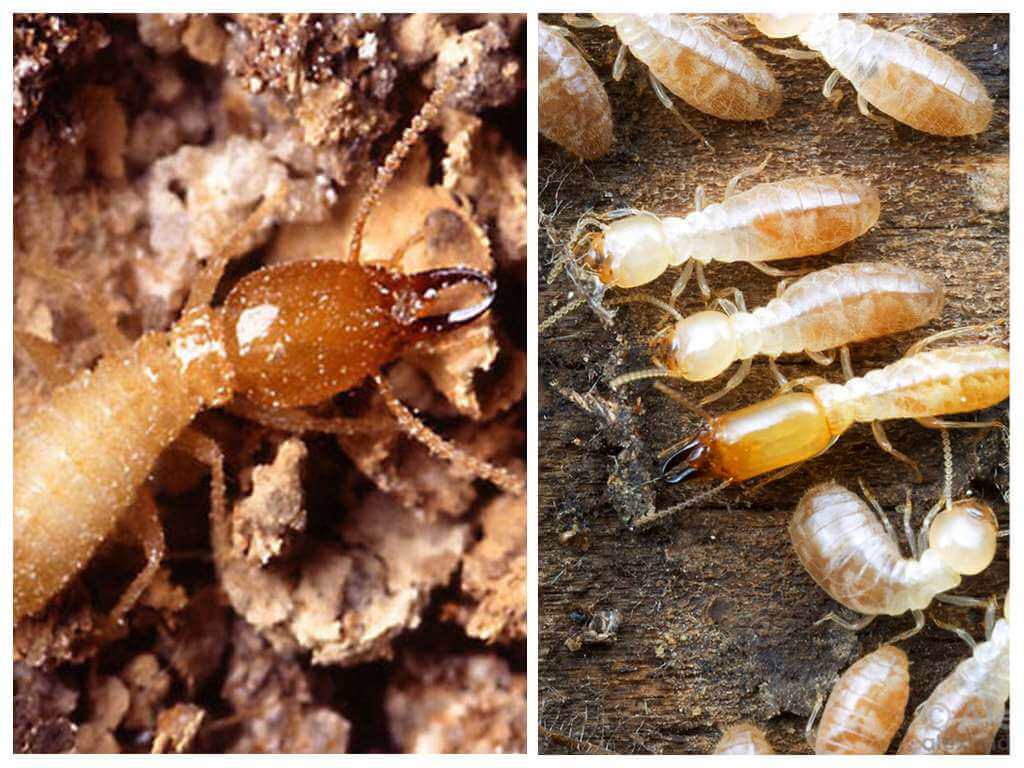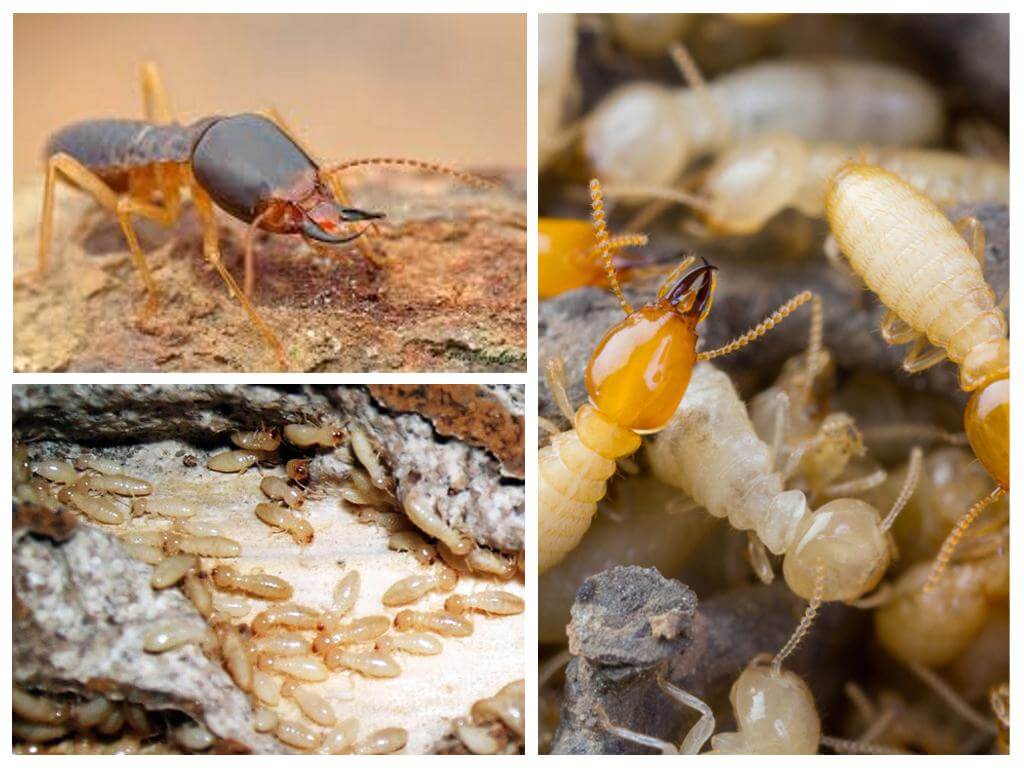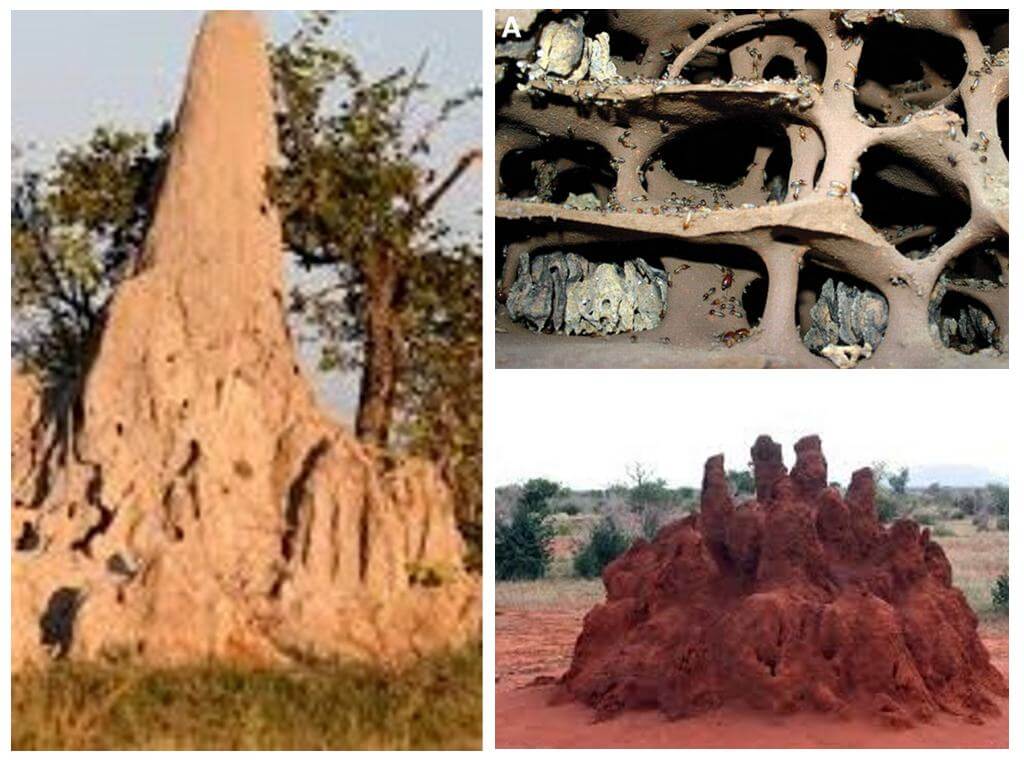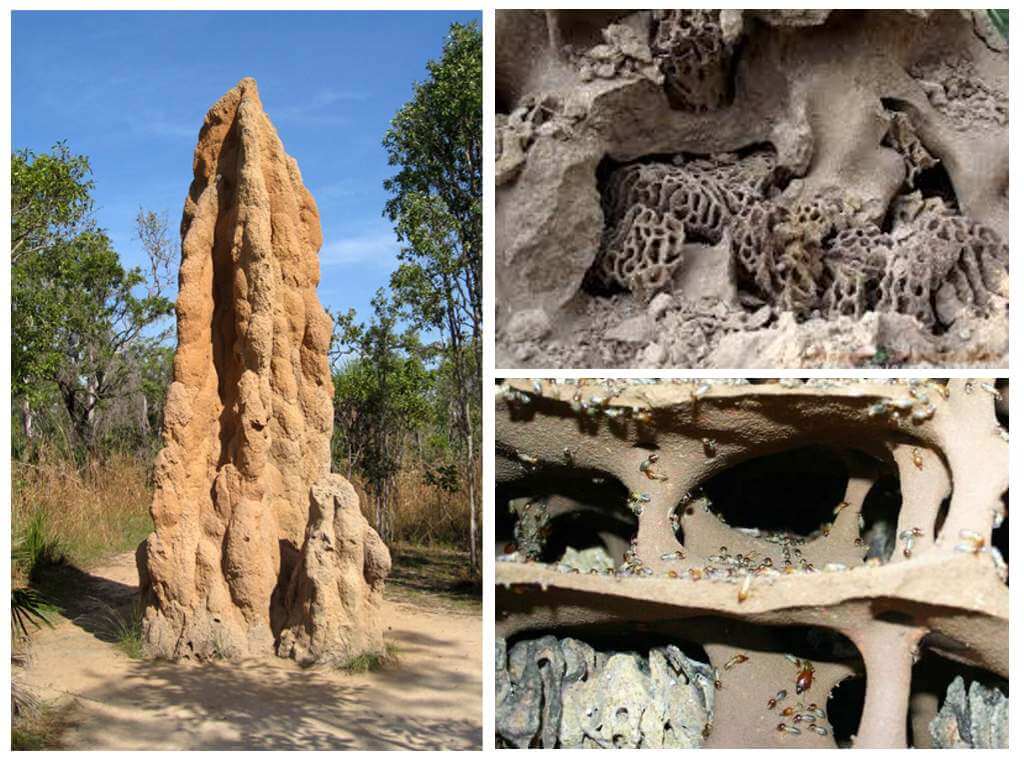Who are the termites
- Termites
- Termites
- Queen of termites
- Working termite
- Termites
- Termites
- Termites nest
- Termites nest
Termites - herbivorous insects belonging to the infraredder of termites. These insects, though remotely resemble antsbut are close relatives cockroaches. About 3106 species and 331 genus have been described, including fossil termites. Scientists suggest that termites stood out from the squad cockroach still in the Paleozoic.
Appearance
Consider how termites look at the example of representatives of different castes. Insect workers have:
- light color;
- covered with a soft chitinous shell body;
- underdeveloped thoracic;
- large head, equipped with powerful mandibles.
The length of their body is from 2 mm to 1.5 cm. The eyes of the workers and soldiers are poorly developed or absent. On the head are threadlike antennae with a large number of segments. The length of the insect is judged by their length.
The size of termites varies depending on which caste an individual belongs to. If the workers are rather small, then the soldiers of the termites have a large (2 cm) body and a large head with so powerful mandibles that they are unable to feed themselves and their working termites feed them. In some species, the mandibles are reduced, but on the head there is an outgrowth from which a nosed soldier “shoots” at the enemy the frightening secret of special glands.
In winged termites there are two pairs of faceted eyes and two simple ocelli. The presence of wings which, after a summer of settling, the insect breaks off at a special seam, distinguishes them from others. Wings (2 pairs) are large, but weak and insects more often “plan” than fly.Winged termites can mate and breed. Workers and soldiers are deprived of this opportunity, because they lack sex glands.
Interesting!
Winged "princes" and "princesses" can replace the dead king or queen. During the summer, they are far from the flow of air and form colonies far from the native mound. Initially, the "royal personages" cope with everything on their own - dig a shelter, care for laying eggs, feed the larvae. But as soon as the “children” grow up and divide into soldiers and workers, they take care of the “parents”.
The king and queen are different sizes. The queen of termites in evolutionarily advanced species is 10 times larger than working insects and very similar to ant womb. A huge number of eggs formed stretches the abdomen so much that the female cannot move independently. If necessary, dozens of working ants transfer it to another chamber.
In primitive species, the queen has slightly more representatives of other castes. The queen of termites lives 10-20 years. Scientists believe that special enzymes with antioxidant properties are responsible for this “longevity”.
The size of the "king" does not exceed the size of working insects. He is constantly in the same chamber with the queen and the main function of the male is fertilization of the female.
The representatives of the rhinothermithid family have a frontal pore or a fountain on their heads, from which the representatives of this family of termites receive anxiety pheromones, which inform the rest of the inhabitants of the nest of danger. The same time, but containing a drop of poison, there are some varieties of soldiers. “Butting” with the head of the enemy, the defender inflicts poison on the surface, which paralyzes the aggressor.
Different types of termites have their own ratio of workers and soldiers. Usually the number of soldiers in the termitary does not exceed 3%. But the network is a species that has no soldiers at all or their share is 12-15%. Japanese scientists have found that, unlike other insect species that have a social organization, the X chromosome gene is responsible for dimorphism in the family of termites. It is he who determines who the larva will become in the future. But this feature is characteristic of advanced species. In primitive species, who the individual will become in the future, is determined by nutrition and special pheromones.
Like any insect, the termite has three pairs of running legs. The color of insects can vary even in one termitary. Inside the complex system of moves there are “colorful” insects - from whitish to dark brown.
Reproduction and development cycle
The termite queen mates with the king many times throughout her long life. In the summer season, workers make holes in the walls through which only 2-3 insects can squeeze at the same time. Travelers describe the departure of winged insects, as thermite "smoke", which rises above the buildings.
"Princesses" attract their future kings with the secret of abdominal glands. Then the pair "digs" the mink, the entrance to which is sealed. It is in this “royal” chamber that pairing takes place. In the lower species, the female lays hundreds, rarely thousands of eggs per week.
But there are species of which the fecundity of the queens is amazing. In odontotermis obesus, the female lays up to 86,000 eggs per day. The queen of macrotermis lays more than 10 million eggs a year. Termites on the photo surround the queen.
Working insects feed and care for her, pull off eggs, collect droplets of secrets from the abdomen, and guard the soldiers.
Interesting!
On the surface of the body of the queen stands out a special secret, rich in pheromones.It is eaten by working termites and spread to distant parts of underground labyrinths. Some scientists believe that this particular secret “unites” the family. Others believe that this is how the control over the number of winged individuals is exercised - they do not appear until the colony has matured, which happens after 2-3 years.
The workers and soldiers, in their essence, are underdeveloped individuals, "frozen" at the larval stage. They do not develop the reproductive system. The secret of the queen, does not allow all termites to turn into insect capable of reproduction. When the queen is aging, the amount of secretion decreases and, under certain conditions, working termites can begin to multiply.
From the fertilized eggs, the larvae appear:
- in workers, a soldier after molting, the larva becomes an adult insect;
- after the second molt, separation into the next stage of the larva or nymph occurs;
- the nymph is larger than the larvae and on the thoracic segments has rudiments of wings;
- before becoming an adult, the larva passes from 3 to 4 cycles of molting;
- there are several ages in the nymphs; at the end of the transformation, the insect grows long wings.
Working termites feed the larvae with the secret of their salivary glands or the crushed fungal spores that grow on their plantations. Reproduction of termites occurs as a result of fertilization, but in the absence of males, females can reproduce in an asexual (parthenogenetic) way. All born individuals are females.
Interesting!
If the queen dies unexpectedly, winged females or nymphs can take on her role in breeding. The latter retain all the features of immaturity. They are called nymphoid. Some types of termites in one nest may have several breeding pairs. This happens if the termitary is very large. Scientists have found that the presence of working termites stimulates egg laying.
It is also surprising that working conditions can also multiply under certain conditions. They need a long period of time to become a reproductive species - 30-40 days. They are called ergatoids. Scientists in the laboratory crossed ergatoids with nymphs and ergatoids. The percentage of castes in the offspring was different.
The table shows the results of the experiments:
| Females | Males | Breeding type | The resulting offspring |
|---|---|---|---|
| nymphoid | - | parthenogenesis | 100% female nymph |
| ergatoids | - | parthenogenesis | 50% died, 50% female nymph |
| nymphoid | nymphoid | sexual | 50% female workers, 50% male workers |
| nymphoid | ergatoids | sexual | 50% female nymphs, 50% male workers |
| ergatoids | nymphoid | sexual | ¼ died, ¾ equally - male nymphs, working males and females |
| ergatoids | ergatoids | sexual | In equal parts of females and males nymphs, females and males - workers |
This diversity is due to the diploidity of males and females of termites. While the colony is developing, winged individuals are not formed. Energy is spent on the production of workers who build, care, clean.
The drywood and wet-wood termites order is characterized by the absence of adult working termites. Their role is played by pseudo-ergates. This group of termites is also called “false” workers. For a long time, the larvae molt, remaining working individuals. But it happens that after some time the pseudo-ergat becomes a soldier.
Power Features
The basis of the diet of many types of termites is cellulose. In the digestive system of working insects, there is a special type of flagellated symbiotic microorganisms capable of destroying cellulose.It is the working termites that feed the soldiers and the queen. Most termites feed on dead branches and tree stumps, fallen leaves, humus. Some species of tropical termites feed on live plants, damaging tea bushes and grasses. But in one of the most progressive species, Termitidae, there are no symbionts and the mechanism of their cellulose assimilation is still unclear.
But it turned out that eating termites is not only cellulose. They plant mushroom gardens, where they grow a special kind of mushroom. In their nest, they drag pieces of wood, leaves. All carefully crushed and "planted" spores of mushrooms. This group of termites is referred to as Macrotermitinae.
Mycelium of fungi destroys inedible lignin, transforming it into a more easily digestible component. Termites eat old parts of gardens, absorbing mycelium, spores and food enriched with various nutrients. For grubs, gardens are a major food supplier.
Interesting!
The famous A. Brem told his comrades how an Arab, who had fallen asleep near the mound, woke up completely naked - the termites ate all his clothes. At the end of the 18th century, termites were accidentally brought to St. Helena, which completely ate the city of Jamestown.
Termites that are found on the territory of the CIS are less “voracious”.But the huge damage caused by the Ashgabat earthquake is due to the fact that 25% of the houses were damaged by termites, which led to their collapse.
Due to the fact that termites are very sensitive to temperature, humidity and sunlight, they rarely appear on the surface, gnawing tree trunks, the logs of the house from the inside, leaving it completely whole outside. Annual damage from termites is calculated in huge amounts. Different types of termites build different nests not only in form, but also in localization.
Different types of nests
Termites live in large families, arranging nests in the soil, trunks and roots of trees or build complex engineering structures - termitaries. The largest mound rises above the ground to a height of 13 meters. In India, a half-destroyed mound was found inside which such a large animal as an elephant could fit.
The main part of the nest is underground. Tunnels, galleries, cameras represent a complex system in which only termites can navigate. The enemies who have broken through inside quickly lose direction and fall into the "paws" of soldiers.There are food storage chambers, delivery rooms, “rooms” for larvae.
Interesting!
The most well-protected, moist, warm and ventilated is the chamber in which the queen dwells with the king. The layout of all the nests is such that their mansions are located in the center of the underground "city". Inside the chamber, the royal couple is always located head to the east, and the end of the abdomen is oriented to the west. The scientists isolated the tsarina’s chamber and, as it were, did not turn it, the couple occupied the same position.
The outer walls are made of a mixture of saliva, particles of wood, clay and excrement. This compound, hardening in the sun is so strong that it is difficult to pick or scrape. Waterproof walls, mushroom "canopies", canopies protect from tropical storms, which are often in the latitudes where termites live.
In addition to the protective function, the outer part of the termitary acts as a duct, maintains a strictly defined temperature and humidity. The workers, depending on the time of day, weather and season, expand or contract air ducts, adjusting the temperature down to 1 ° С.
Special "waterpots" delivered from the depths of the wet earth.Describing the termites of Ivory Coast, Swiss M. Luscher noted that they deliver moisture from layers located at a depth of 10-12 meters. But this is not the limit - in South Africa, termites penetrate the water to a depth of about 40 meters.
In the center of the building, 20-30 cm from the surface of the soil, insects arrange a “nursery” lined with soft matter in which there are larvae. On both sides there are rooms for storage of eggs, just below the larval chamber there are apartments of the queen. Even lower are warehouses and storerooms that are connected by a system of moves to power supplies.
Subterranean nests of the African termite Apicotermes are connected by a complex duct system that provides insects with oxygen even at depth. In Australia, insects build the so-called "compass" structures. These flat termitaries are always oriented along the north-south axis, which does not allow the nest to overheat.
It is worth destroying the upper part of the termitary, as from its depths numerous inhabitants are bound to damage. All work is done from the inside. And only a small handful of soldiers bravely defend the resulting "entrance" outside, attacking ants,lizards and other lovers to profit by termites. Workers quickly close up the breach from the inside, and the daredevils remain outside the mound to die.
Interesting!
There are many incredible stories about termites that have little in common with reality. Descriptions of these insects are in the novel by S. Lem, Mayne Reed, J. Verne. They are portrayed as evil, attacking everything and everyone insects with huge jaws. In fact, in the termites often along with the inhabitants live "lodgers" - termites. It can be beetles, small animals and birds. They seek shelter from the weather and predators under the protection of reliable walls of the mound.
In the book I. The Crossed Antenna Password by I. Khalifman about termites life is written so fascinating and such incredible facts that inevitably you begin to admire these tiny whitish creatures.

